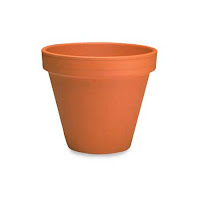[Later edit] With heavily overcast skies and brisk wind temps dropped to 12 C (54 F) by late afternoon. Because the next few days are forecast to be cold and grey we brought out the second trouble light and put it in the greenhouse. The temp went up to 15 C again. I am now using the top two shelves but tomorrow morning I will block off the bottom (third) shelf, so the lights don't have as much volume to heat. I'd like to see the temperature at 18 C if possible.
When we put them out this morning there were a few more Roma tomato sproutlings in the (second) flat I started a week ago. Now, two hours later, several Starfire, Purple Prince and Brandywine tomatoes have emerged, plus a few onions and several Thai basil seedlings! I'd been a bit worried that the wildly varying temperatures in the greenhouse the past few days might have cooked/chilled the tender seeds past the point of no return. Evidently not. By the end of the day the raab, bok choi, and broccoli seedlings were showing secondary leaves! The Brussel sprout seedlings look considerably better than they did yesterday, when they simply looked like little mutated knobs on stalks. Several more came up during the night as well.
 To remind me that spring will eventually arrive I looked through and found a picture of one of last summer's squash plants. I went out yesterday afternoon and turned the soil out of one of the short but stout containers I'd grown squash in last summer. As I remembered it has a single drainage hole in the bottom, but it also has an attached plug, so it can be stoppered. A much taller container shoehorns neatly inside it, leaving an 8" space between them. With a bit of jiggery-pokery I can create a large self-watering container from the two. Since I have several of each of these containers I can make several large SWCs. I'm thinking melons, squash, maybe tomatoes?
To remind me that spring will eventually arrive I looked through and found a picture of one of last summer's squash plants. I went out yesterday afternoon and turned the soil out of one of the short but stout containers I'd grown squash in last summer. As I remembered it has a single drainage hole in the bottom, but it also has an attached plug, so it can be stoppered. A much taller container shoehorns neatly inside it, leaving an 8" space between them. With a bit of jiggery-pokery I can create a large self-watering container from the two. Since I have several of each of these containers I can make several large SWCs. I'm thinking melons, squash, maybe tomatoes?
And on a different subject; There's a large willow adjacent to our neighbour's place. Beneath it is a flower bed, maybe five by eight feet, roughly oval in shape. There are a few bulbs in it, none of which bloomed last year. (They probably need to be divided and replanted, a task I might take on in the fall.) Otherwise this flower bed was a weed patch and eye sore last summer, with weeds higher than my waist. Oddly enough the neighbour kept it watered, which made little sense. I flew in there one day and weeded it. There was nothing growing in it at all when I finished, but at least it looked tidy.
Yesterday he told me that I can use that area this year. I am delighted! I have some malvas, delphiniums and cosmos seeds that will probably grow like crazy in there. I might add some aged manure and ring the bed with some kind of "attractive" veggie. I have to go over and fork around in the ground to see how deep the sandy soil is. It has a rock border, and is underlain by enormous willow roots so it won't be root crops.
Outside the purple finch is tenderly feeding his lady love sunflower seeds he's shelled for her. He sure knows how to sweet talk a gal.























